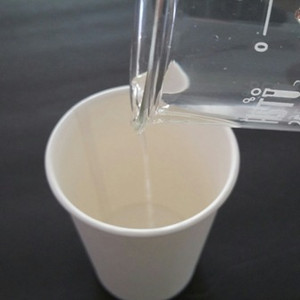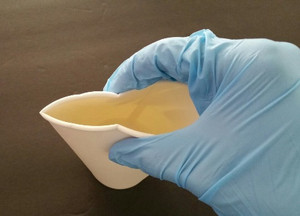
FREE SCIENCE EBOOK
7 Simple Science Experiments

Do a fun spin on the classic baking soda and vinegar reaction! You can use any kind of gummy candy, but gummy worms will look the most like eels as they twist and squirm.
- Gummy worms
- Baking soda
- Water
- Vinegar
- 2 beakers
- Scissors
- Using scissors, cut the gummy worms in half or into quarters lengthwise. You want long, thin strips of worms.
- Drop the worm strips in one glass. Add a couple of spoonfuls of baking soda and enough water to dissolve some of the baking soda. If all of the baking soda dissolves, add more until some undissolved powder remains.
- Let the worms soak in the baking soda solution for 15 minutes to half an hour.
Pour vinegar into the other glass. Drop a baking-soda-soaked worm into the vinegar.
At first, nothing appears to happen. Then, bubbles start to form on the surface of the worm. The worm starts to move. After some time, the reaction stops and the worm stills. The gummy worms wiggle because a chemical reaction between baking soda (sodium bicarbonate) and vinegar (weak acetic acid) produces carbon dioxide gas. The tiny gas bubbles released by the reaction stick to the body of the gummy worms, eventually merging into bubbles big enough to float part of the worm. If the gas bubble detaches, it floats to the surface while that part of the gummy worm sinks back down.
Salt is an naturally-occurring mineral and a chemical compound with amazing properties. These properties enable salt to be used in everything from preserving food to making it taste better. Epsom salt is primarily used for health reasons. People use it to make soft water for relaxing, treat constipation, and sore muscles. You can use it to make Epsom salt crystals!
Usually it takes several days to grow crystals. However, this super-easy recipe gives you a cup full of needle-like Epsom salt crystals in just a few hours!
- Epsom salt
- Food coloring
- Beaker, cup, or small bowl
1. In the beaker, stir 1/2 cup of Epsom salts with 1/2 cup of very hot tap water for at least one minute. This creates a saturated solution, meaning no more salt can dissolve in the water. (Some undissolved crystals will be at the bottom of the glass.)
2. Add a couple drops of food coloring if you want your crystals to be colored.
3. Put the beaker in the refrigerator.
4. Check on it in a few hours to see a beaker full of epsom salt crystals! Pour off the remaining solution to examine them.
Epsom salt is another name for the chemical magnesium sulfate. The temperature of the water determines how much magnesium sulfate it can hold; it will dissolve more when it is hotter.
Cooling the solution rapidly encourages fast crystal growth since there is less room for the dissolved salt in the cooler, denser solution. As the solution cools, the magnesium sulfate atoms run into each other and join together in a crystal structure.
Crystals grown this way will be small, thin, and numerous. Left undisturbed, the crystals should last months or more!
Deoxyribonucleic acid (DNA) is a chemical found in the nucleus of cells that contains the blueprint for the development and function of living organisms. It’s compared to a set of blueprints since it contains the instructions on how to build cells. The instructions are divided into segments along a strand of DNA and are called genes.
Genes provide the code for the production of a protein and control hereditary characteristics such as eye color or personality behaviors. Proteins determine cell type and function, so a cell knows whether it is a skin cell, a blood cell, a bone cell, etc., and how to perform its duties.
- Beaker
- Test tube with tight fitting lid
- Lab scoop
- Isopropyl or ethyl alcohol (at least 70% concentration, higher is better—we used 95%), chilled in freezer for several hours
- Pipette (if alcohol doesn’t come in a dropper bottle)
- Paper cup
- Safety goggles
- Lab apron
- Gloves
- Sodium chloride (salt)
- Distilled or bottled water
- Liquid dish soap or hand soap
- Stir rod or wooden skewer (optional)
- Small glass vial (optional)
DNA stands for deoxyribonucleic acid (DNA) and it’s a molecule found in the nucleus of plant and animals cells. Passed from one generation of living organisms to the next through reproduction, DNA contains the blueprint for development, survival, and reproduction.
It’s compared to a set of blueprints since it houses the biological instructions that tell an organism how to build cells and what role they’ll play. Sometimes DNA’s structure is described as a twisted ladder that scientists refer to as a “double helix.”
The rungs of DNA are made from four different types of nitrogen-containing bases paired together through hydrogen bonds: adenine (A), thymine (T), cytosine (C), and guanine (G). Adenine and thymine connect to each other and cytosine and guanine connect to each other.
The sides of the ladder, also called the backbone of the DNA molecule, is made from an alternating pattern of phosphate, sugar, then phosphate again. Together, this grouping of a phosphate, sugar, and nitrogenous base makes up a subunit of DNA called a nucleotide, a sort of chemical building block.
But how can a molecule hold information? The base sequence determines the biological instructions that will be passed on through a DNA strand. These instructions are divided into segments along a strand of DNA and are called genes.
Genes provide the code for the production of a protein and control hereditary characteristics, such as eye color or personality behaviors. Proteins determine cell type and function, so a cell knows whether it is a skin cell, a blood cell, a bone cell, etc., and how to perform its duties.
When you swished the saltwater around in your mouth and scraped your teeth along the inside of your cheek, you were also collecting cheek cells. The salt helped them clump together.
The degreasing agents in the soap worked to break down the cell membrane to release the DNA, which is housed inside the cell’s nucleus. Gently mixing the soap and mouthwash solution ensured you didn’t break up the DNA clumps too much. The rest of the cheek cells remained in the saltwater-soap solution.
The strand of clumped together DNA would have eventually dissolved in the saltwater, but since it’s not soluble in alcohol, it precipitates out where the liquid layers meet.
















